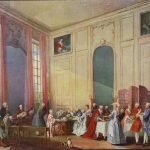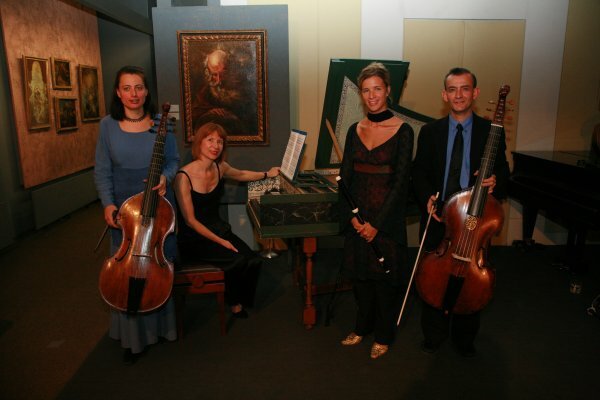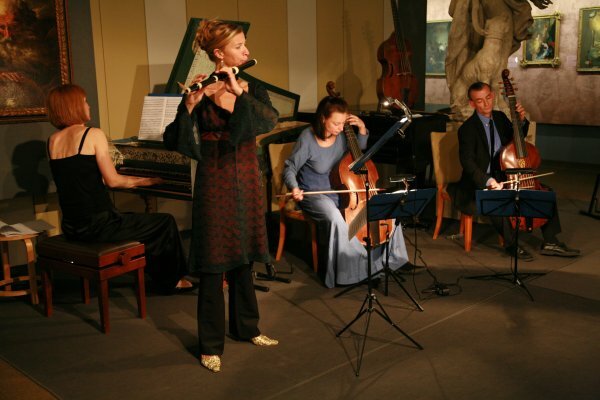Mozart in London

The influence that great masters played in the musical development of the young Mozart is quite evident: Amadeus did not arise by spontaneous generation, but rather was planted and throve on an incredibly fertile and well-cultivated musical soil.
Documents show that Mozart was well aware of the magnificent heritage of the Bach Family, which he was able to incorporate into his compositional style. The fuges of Johann Sebastian, he claimed, were simply inimitable. The manner of Carl Philipp Emanuel Bach he esteemed highly, as did most of the contemporary musical world : indeed, when one spoke of “Bach“ in the 18th C. one generally meant Philipp Emanuel, and not his illustrious father! The young Mozart met and learned from Johann Christian Bach while visiting London, copying and rearranging some of this master’s works for subsequent personal use. On this occasion he also met the incomparable violist da gamba, Carl Friedrich Abel, who had studied with Johann Sebastian in Leipzig before establishing himself in London, where, together with Johann Christian, he organised an enormously successful concert series in the London salons which lasted from 1765 to 1782. Not only did Mozart imitate the famous “allegro cantabile“ of these two London masters, he also wrote a sonata for Mr. Abel, regrettably now lost. His admiration for these masters is well documented in the writings of both Mozart and his father. One of the Abel’s symphonies was long held to be a work by Mozart, because the score had been meticulously copied by Amadeus for purposes of study and emulation.
When Mozart arrived in London in 1764, the memory of the great Händel was still very much alive. He had died only five years earlier, but his fame endured unflagginlgy in the ever-present oratorio performances throughout the realm. These made a deep impression on the young Mozart, who fashioned some of his church music in this monumental style. Mozart also honoured his German colleague in orchestrating the Messias for performances in his homeland.
Programme
| Johann Christian Bach (1735-1782) | Quartett in D Major, Op. VIII, Nr. 5 Allegretto – Rondeaux |
| — | — |
| Johann Christian Bach* *W.A.Mozart added the parts for two violins and violoncello |
Sonata in D Major |
| — | — |
| Carl Friedrich Abel (1724-1787) |
Quartett in G Major |
| * * * * * * | |
| Carl Friedrich Abel | Sonate in d minor (Allegro) – Adagio – Tempo di Minuetto |
| — | — |
| Georg Friedrich Händel (1685-1759) | Concertante Cantata: “Tra le Fiamme” |

Orpheon Consort
| José Vázquez – violin, viola da gamba, direction | Christine Esser (Zürich) – soprano |
| Christa Opriessnig – violin, viola da gamba | Annie Laflamme – Traversflöte |
| Juan Carlos Higuita – Violine | Kinga Krommer – Traversflöte |
| Lúcia Krommer – viola da gamba, violoncello | Borbála Dobozy – Cembalo |

Instrumentarium
Violin by Nicola Amati, Cremona, 1669
Violin by Sebastian Kloz, Mittenwald, 1733
Bass viola da gamba by Jakob Stainer, Absam, 1671
Bass viola da gamba by Joachim Tielke, Hamburg, 1683
Transverse Flute after Carlo Palanca and J. H. Rotterburg
Violoncello by Montagnana-School, Veneto, ca. 1700
Harpsichord after Jan Ruckers, Antwerp, 1638,
enlarged in France by William Horn (Brescia)
Texts to the vocal works
| Tra le fiamme tu scherzi per gioco, o mio core, per farti felice t´inganna una vaga beltà. Cadon mille farfalle nel foco, e si trova una sola fenice che sorge se a morte sen va. |
Um die Flamme kreist du spielerisch, o mein Herz; um deine Sehnsucht zu entzünden, betrügt dich eine begeisternde Schönheit. Tausend Schmetterlinge fallen ins Feuer, und nur ein einziger Phönix findet sich, der aus dem Sterben wieder aufsteigt. |
| Dedalo già le fortunate penne tessea con mano ardita e con tenera cera piuma a piuma aggiungea. Icaro il fanciuletto sovente confondea l’ingegnoso lavoro; ah, cosí mai trattato non avesse e cera e piume: per chi non nacque augello il volare è portento, il cader è costume |
Dädalus webte die glücklichen Schwingen mit kühner Hand und fügte mit weichem Wachs Feder an Feder. Ikarus, der zarte Knabe, verwirrte oft die kunstvolle Arbeit. Ach hätte er doch nie mit Wachs und Federn hantiert: Für den, der nicht als Vogel geboren, ist Fliegen ein Wunder, das Fallen aber Gewohnheit |
| Pien di nuovo e bel diletto sciolse l´ali il giovinetto e con l´aure già scherzando. Ma del volo si gradito troppo ardito l´onda ancor va mormorando. |
Erfüllt von neuem und schönem Vergnügen breitet der Jüngling seine Flügel aus und spielt schon mit den Lüften. Aber: Von diesem angenehmen, doch zu gewagten Flug erzählt murmelnd nur noch das Meer. |
| Sí, sí, pur troppo è vero: nel temerario volo tanti gl´Icari son, Dedalo un solo. |
Ja, leider ist es die Wahrheit: Für übermütigen Flug gibt´s viele Ikarus´, aber Dädalus gibt´s nur einen. |
| Voli per l´aria chi può volare, scorra veloce la terra il mare, parta, ritorni nè fermi il piè. Voli ancor l´uomo ma coi pensieri che delle piume ben più leggeri e più sublimi il ciel gli diè. |
Es fliege durch die Luft, wer fliegen kann, durchstreife eilends Länder und Meere, ziehe fort, kehre wieder und bleibe nicht stehen. Es fliege auch der Mensch, aber mit den Gedanken, dieleichter noch als Federn und herrlicherihm der Himmel gab. |
| L´uomo che nacque per salire al cielo ferma il pensier nel suolo, e poi dispone il volo con ali che si finge, e in sé non ha. |
Der Mensch, der geschaffen ist himmelwärts zu steigen, haftet in seinem Denken am Boden und rüstet dann zum Fluge mit Flügeln, die nachgemacht sind und ihm fremd. |
| Tra le fiamme tu scherzi per gioco… | Um die Flamme kreist du spielerisch… |